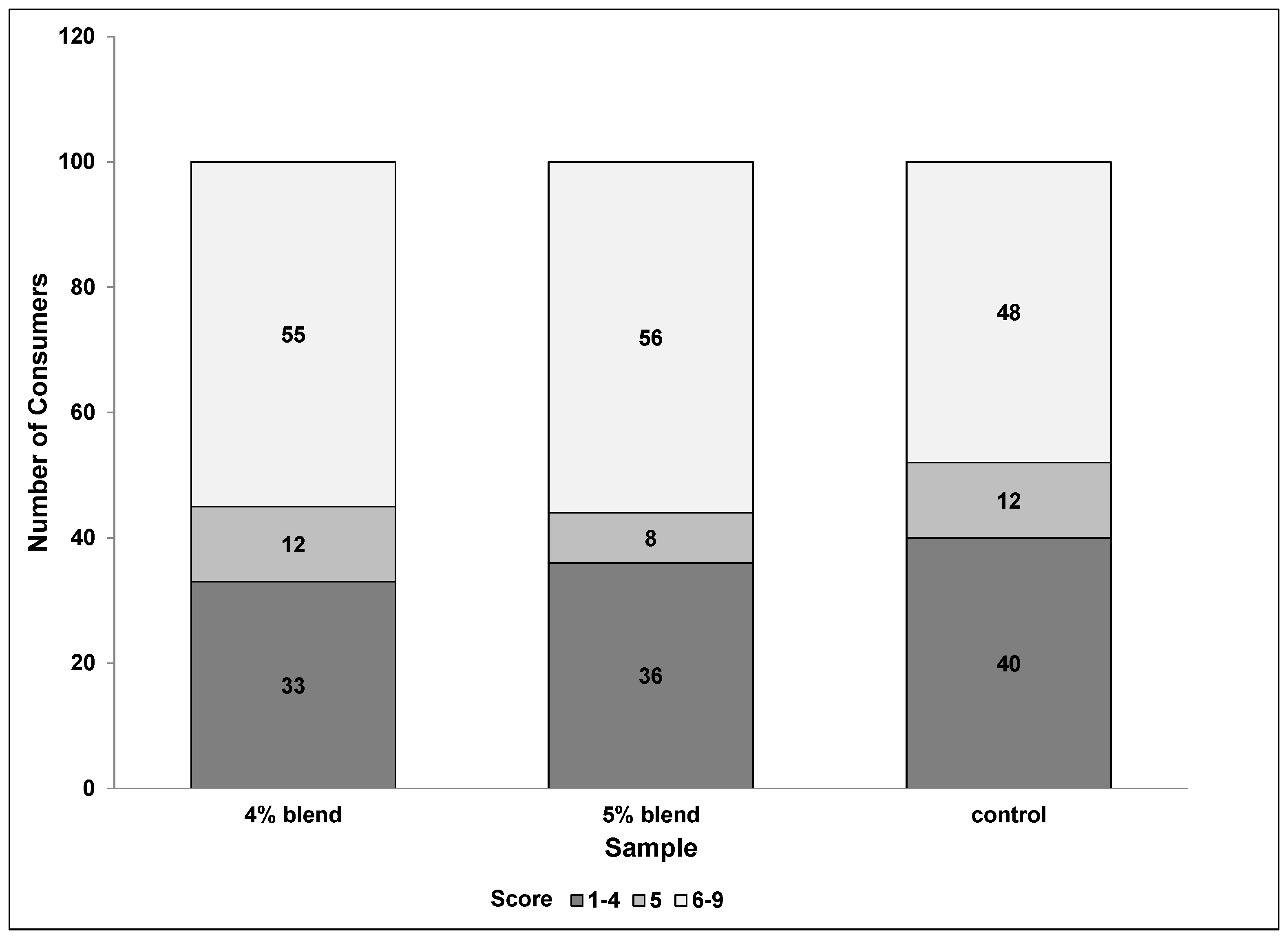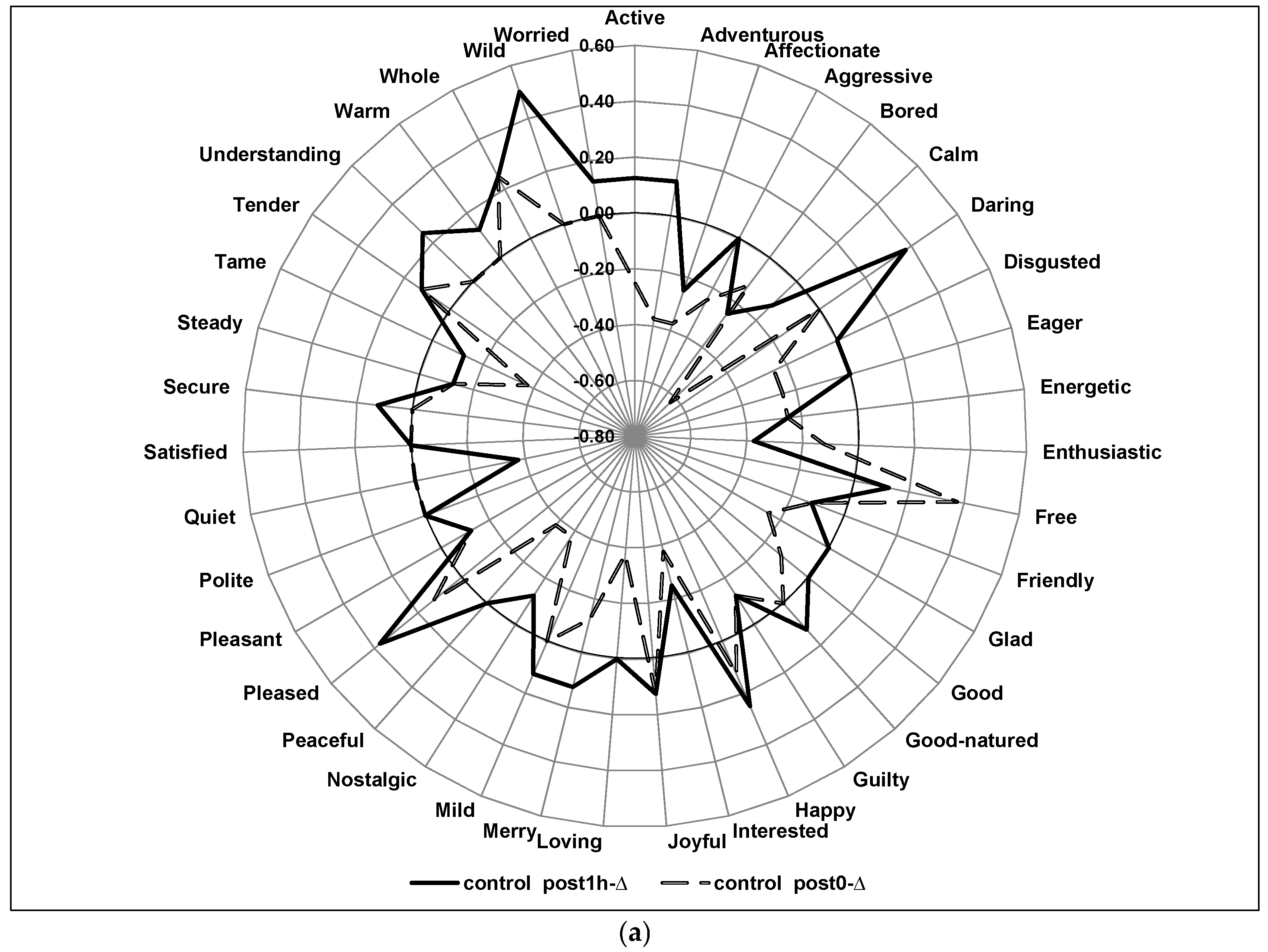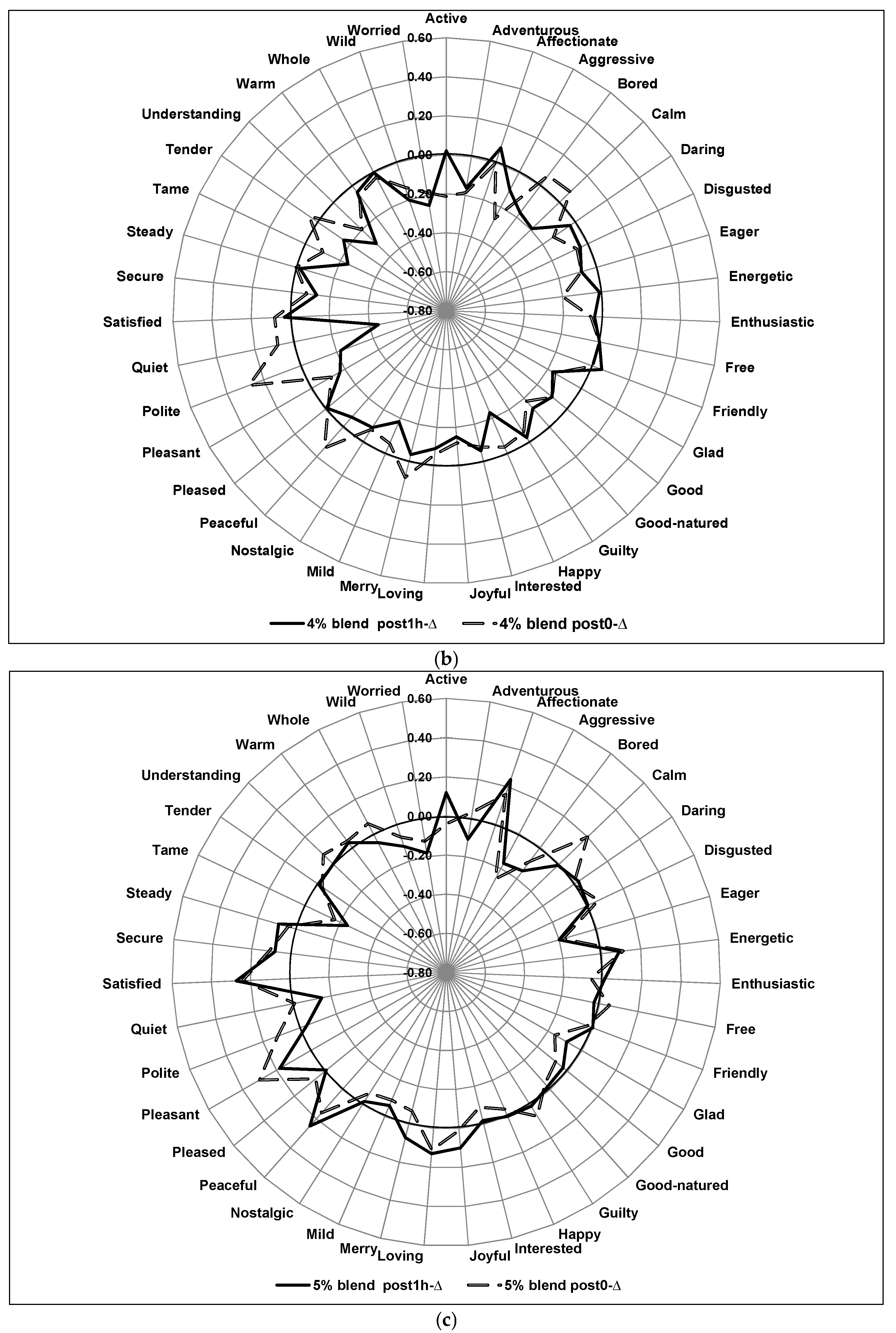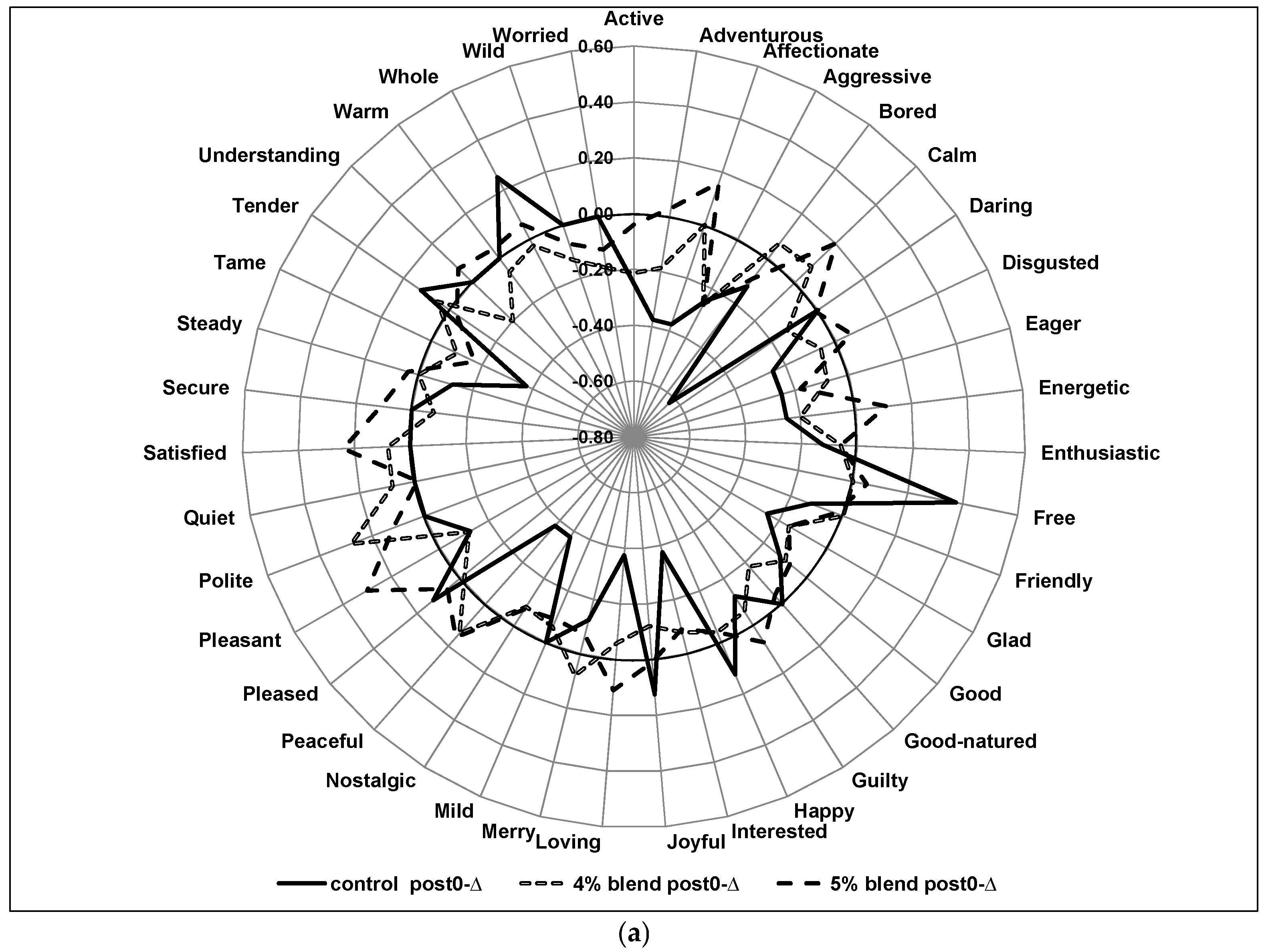Spices in a Product Affect Emotions: A Study with an Extruded Snack Product † †
Abstract
:1. Introduction
1.1. Food and Emotion
1.2. Spices and Antioxidant Activity
2. Materials and Methods
2.1. Preparation of the Extruded Samples Containing the Spice Blend
2.2. Consumer Studies
2.2.1. Consumers
2.2.2. Samples and Testing
2.3. Consumer Studies—Emotion Testing
2.4. Clinical Study
2.4.1. Subjects and Samples
2.4.2. Total Antioxidant Capacity
2.4.3. Glycemic Index
2.5. Data Analysis
3. Results and Discussion
3.1. Consumer Studies
3.1.1. Overall Liking Data
3.1.2. Overall Liking—Hedonic vs. Emotion Data
3.2. Emotion Differences by Blend and Time
3.3. Clinical Study
3.3.1. Antioxidant Levels in the Plasma
3.3.2. Glycemic Index
4. Conclusions
Author Contributions
Conflicts of Interest
References
- Kenney, E.; Adhikari, K. Recent developments in identifying and quantifying emotions during food consumption. J. Sci. Food Agric. 2016, 96, 3627–3630. [Google Scholar] [CrossRef] [PubMed]
- Macht, M. How emotions affect eating: A five-way model. Appetite 2008, 50, 1–11. [Google Scholar] [CrossRef] [PubMed]
- Chrea, C.; Grandjean, D.; Delplanque, S.; Cayeux, I.; Le Calvee, B.; Aymard, L.; Velazco, M.; Sander, D.; Scherer, K.R. Mapping the semantic space for the subjective experience of emotional responses to odors. Chem. Senses 2009, 34, 49–62. [Google Scholar] [CrossRef] [PubMed]
- Seubert, J.; Rea, A.F.; Loughead, J.; Habel, U. Mood induction with olfactory stimuli reveals differential affective responses in males and females. Chem. Senses 2009, 34, 77–84. [Google Scholar] [CrossRef] [PubMed]
- Rétiveau, A.; Chambers IV, E.; Milliken, G. Common and specific effects of fine fragrances on the mood of women. J. Sens. Stud. 2004, 19, 373–394. [Google Scholar]
- Freyberg, R.; Ahren, M.-P. A preliminary trial exploring perfume preferences in adolescent girls. J. Sens. Stud. 2011, 26, 237–243. [Google Scholar] [CrossRef]
- Kergoat, M.; Giboreau, A.; Nicod, H.; Faye, P.; Diaz, E.; Beetschen, M.-A.; Meyer, T. Consumer preference for tactile softness: A question of affect intensity? J. Sens. Stud. 2012, 27, 232–246. [Google Scholar] [CrossRef]
- Rollins, B.Y.; Riggs, N.R.; Spruijt-Metz, D.; McClain, A.D.; Chou, C-P.; Pentz, M.A. Psychometrics of the eating in Emotional Situations Questionnaire (EESQ) among low-income Latino elementary-school children. Eat. Behav. 2011, 12, 156–159. [Google Scholar] [CrossRef] [PubMed]
- Polivy, J.; Herman, C.P.; Deo, R. Getting a bigger slice of the pie. Effects on eating and emotion in restrained and unrestrained eaters. Appetite 2010, 55, 426–430. [Google Scholar] [CrossRef] [PubMed]
- Macht, M.; Haupt, C.; Salewsky, A. Emotions and eating in everyday life: Application of the experience-sampling method. Ecol. Food Nutr. 2004, 43, 327–337. [Google Scholar] [CrossRef]
- Moskowitz, H.; Silcher, M.; Beckley, J.; Minkus-Mckenna, D.; Mascuch, T. Sensory benefits, emotions and usage patterns for olives: Using internet-based conjoint analysis and segmentation to understand patterns of response. Food Qual. Preference 2005, 16, 369–382. [Google Scholar] [CrossRef]
- King, S.; Meiselman, H. Development of a method to measure consumer emotions associated with foods. Food Qual. Preference 2010, 21, 168–177. [Google Scholar] [CrossRef]
- Steptoe, A.; Pollard, T.M.; Wardle, J. Development of a measure of the motives underlying the selection of food: The food choice questionnaire. Appetite 1995, 25, 267–284. [Google Scholar] [CrossRef] [PubMed]
- Gibson, E. Emotional influences on food choice: Sensory, physiological, and psychological pathways. Physiol. Behav. 2006, 89, 53–61. [Google Scholar] [CrossRef] [PubMed]
- Kuenzel, J.; Zandstra, E.H.; Lion, R.; Blanchette, I.; Thomas, A.; El-Deredy, W. Conditioning unfamiliar and familiar flavours to specific positive emotions. Food Qual. Preference 2010, 21, 1105–1107. [Google Scholar] [CrossRef]
- Desmet, P.; Schifferstein, H. Sources of positive and negative emotions in food experience. Appetite 2008, 50, 290–301. [Google Scholar] [CrossRef] [PubMed]
- Piqueras-Fiszman, B.; Ares, G.; Varela, P. Semiotics and perception: Do labels convey the same messages to older and younger consumers? J. Sens. Stud. 2011, 26, 197–208. [Google Scholar] [CrossRef]
- Cardello, A.V.; Meiselman, H.L.; Schutz, H.G.; Craig, C.; Given, Z.; Lesher, L.L.; Eicher, S. Measuring emotional responses to foods and food names using questionnaires. Food Qual. Preference 2012, 24, 243–250. [Google Scholar] [CrossRef]
- Valko, M.; Leibfritz, D.; Moncol, J.; Cronin, M.; Mazur, M.; Telser, J. Free radicals and antioxidants in normal physiological functions and human disease. Int. J. Biochem. Cell Biol. 2007, 39, 44–84. [Google Scholar] [CrossRef] [PubMed]
- Rao, P.V.; Gan, S.H. Cinnamon: A multifaceted medicinal plant. Evid. Based Complement. Altern. Med. 2014, 2014, 642942. [Google Scholar] [CrossRef] [PubMed]
- Kannapan, S.; Jayaraman, T.; Rajasekar, P.; Ravichandran, M.; Anuradha, C. Cinnamon bark extract improves glucose metabolism and lipid profile in the fructose-fed rat. Singap. Med. J. 2006, 47, 858–863. [Google Scholar]
- Talpur, N.; Echard, B.; Ingram, C.; Bagchi, D.; Pruess, H. Effects of novel formulation of essential oils on glucose-insulin metabolism in diabetic and hypertensive rats: A pilot study. Diabetes Obes. Metab. 2005, 7, 193–199. [Google Scholar] [CrossRef] [PubMed]
- Dugoua, J.; Seely, D.; Perri, D.; Cooley, K.; Forelli, T.; Mills, E.; Koren, G. From type 2 diabetes to antioxidant activity: A systematic review of the safety and efficacy of common and cassia cinnamon bark. Can. J. Physiol. Pharmacol. 2007, 85, 837–847. [Google Scholar] [CrossRef] [PubMed]
- Bone, K. Ginger. Br. J. Phytother. 1997, 4, 110–120. [Google Scholar]
- Shan, B.; Cai, Y.; Sun, M.; Corke, H. Antioxidant capacity of 26 spice extracts and characterization of their phenolic constituents. J. Agric. Food Chem. 2005, 53, 7749–7759. [Google Scholar] [CrossRef] [PubMed]
- Shobana, S.; Naidu, A. Antioxidant activity of selected Indian spices. Prostaglandins Leukot. Essent. Fat. Acids 2000, 62, 107–110. [Google Scholar] [CrossRef]
- Haytowitz, D.B.; Bhagwat, S. USDA Database for the Oxygen Radical Absorbance Capacity (ORAC) of Selected Foods, Release 2. US Department of Agriculture, Agricultural Research Service. 2010. Nutrient Data Laboratory Home Page. Available online: http://www.ars.usda.gov/nutrientdata/orac (accessed on 1 June 2017).
- Prior, R.; Wu, X.; Gu, L.; Jacob, R.; Cao, G.; Cook, R.A. Plasma antioxidant capacity changes following a meal as a measure of the ability of a food to alter in vivo antioxidant status. J. Am. Coll. Nutr. 2007, 26, 170–171. [Google Scholar] [CrossRef] [PubMed]
- Haub, M.D.; Hubach, K.L.; Al-tamimi, E.K.; Ornelas, S.; Seib, P.A. Different types of resistant starch elicit different glucose responses in humans. J. Nutr. Metab. 2010, 2010, 230501. [Google Scholar] [CrossRef] [PubMed]
- Benton, E.; Donohoe, R. The effects of nutrients on mood. Public Health Nutr. 1999, 2, 403–409. [Google Scholar] [CrossRef] [PubMed]
- Suppapitiporn, S.; Kanpakso, N.; Suppapitiporn, S. The effect of cinnamon cassia powder in type 2 diabetes mellitus. J. Med. Assoc. Thail. 2006, 89, S200–S205. [Google Scholar]
- Vanschoonbeek, K.; Thomassen, B.; Senden, J.; Wodzig, W.; Van Loon, L. Cinnamon supplementation does not improve glycemic control in postmenopausal type 2 diabetes patients. J. Nutr. 2006, 136, 977–980. [Google Scholar] [PubMed]






| Ingredients | Control | 4% Blend | 5% Blend |
|---|---|---|---|
| Total Spice Blend | N/A | 4.0 | 5.0 |
| Salt | 1.0 | 1.0 | 1.0 |
| Corn Flour | 77.0 | 73.9 | 73.1 |
| Apple Fiber | 22.0 | 21.1 | 20.9 |
| Moisture of the final product (% w/w) | 8.8 | 9.1 | 9.8 |
| Sample | Overall Liking | Appearance Liking | Flavor Liking | Texture Liking |
|---|---|---|---|---|
| 5% Blend | 5.4 a | 4.0 a | 5.3 a | 5.6 a |
| 4% Blend | 5.4 a | 3.9 a | 5.3 a | 5.2 b |
| Control | 5.2 a | 4.0 a | 5.2 a | 5.6 a |
| Total Antioxidant Capacity (Plasma) | mM TE ± SD |
| Control—antioxidant activity at 0 h | 19.4 ± 1.8 c |
| 4% Spice Blend—antioxidant activity at 0 h | 20.3 ± 1.1 a,b |
| Control—antioxidant activity after 2 h | 20.0 ± 1.7 b,c |
| 4% Spice Blend—antioxidant activity after 2 h | 20.8 ± 1.8 a |
| Glycemic Index | Average Area Under the Curve ± SD |
| Control | 117.4 ± 47.0 a |
| 4% Spice Sample | 115.6 ± 47.0 a |
© 2017 by the authors. Licensee MDPI, Basel, Switzerland. This article is an open access article distributed under the terms and conditions of the Creative Commons Attribution (CC BY) license (http://creativecommons.org/licenses/by/4.0/).
Share and Cite
Bell, B.; Adhikari, K.; Chambers, E., IV; Alavi, S.; King, S.; Haub, M. Spices in a Product Affect Emotions: A Study with an Extruded Snack Product †. Foods 2017, 6, 70. https://doi.org/10.3390/foods6080070
Bell B, Adhikari K, Chambers E IV, Alavi S, King S, Haub M. Spices in a Product Affect Emotions: A Study with an Extruded Snack Product †. Foods. 2017; 6(8):70. https://doi.org/10.3390/foods6080070
Chicago/Turabian StyleBell, Brandon, Koushik Adhikari, Edgar Chambers, IV, Sajid Alavi, Silvia King, and Mark Haub. 2017. "Spices in a Product Affect Emotions: A Study with an Extruded Snack Product †" Foods 6, no. 8: 70. https://doi.org/10.3390/foods6080070






